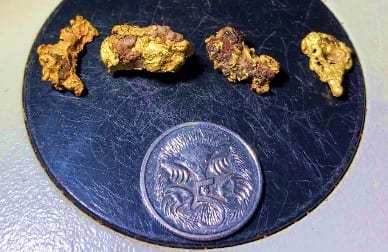Over 80 gold nuggets found within a newly discovered extensive gold-in-soils anomaly
Core Lithium Ltd (ASX: CXO) has made a series of significant new gold at its wholly owned Bynoe Gold Project in the Northern Territory of Australia.
In recent weeks, soil sampling, regional mapping and reconnaissance rock chip sampling have led to the discovery of a series of exciting new gold prospects in the northern part of the Bynoe Project tenements.
These four new gold prospects link together as a series of steep-dipping, north-striking sulphide rich and gold-bearing quartz veins hosted within silicified and sulphide-altered metasedimentary rocks of the Burrell Creek formation.
Over gold 80 nuggets measuring at up to 5 grams have been recovered by detecting work carried out by the Core field team.
An extensive soil sampling grid has also been collected along the trend and highlights regular high-grade gold-in-soils, including 11 samples above 1g/t gold.
Ro k chips are similarly highly anomalous in gold, with 17 samples above 1g/t. The peak value for soils is 32g/t and for rock chips is 30g/t Au. This is consistent with those high-grade samples having coarse free gold.
The most prolific gold is hosted as free coarse grains within both the quartz veins and in fractures and intergrain positions within altered fractured graphitic schist-conglomerate. However, at least some of the gold is also finely disseminated or contained within sulphides including arsenopyrite and galena. The relative abundance and distribution of these different styles of gold mineralisation is difficult to establish with the limited data available at present, but can be tested in future programmes.
Managing Director, Stephen Biggins, said a particularly interesting aspect of the gold mineralisation at these prospects is that the host rocks are notably hard and silicified. Where fresh, there is also evidence for sulphide alteration that is not necessarily associated with quartz veins.
Mr Biggins added that this is an exciting observation, as it brings into play the potential for sedimentary hosted gold of a scale larger than that within the quartz veins.
Gold distribution in quartz veins and in the surrounding sulphide and silica altered host rocks can only be assessed via drilling, which is currently underway. Core’s first drilling program at these new prospects, a shallow RAB drilling programme, is designed to test all rock types and structural positions, not just the obvious quartz veins.
“We see these recent discoveries as the most significant evidence of large-scale gold mineralising systems at play in the Bynoe Gold Project to date,” Mr Biggins said.












